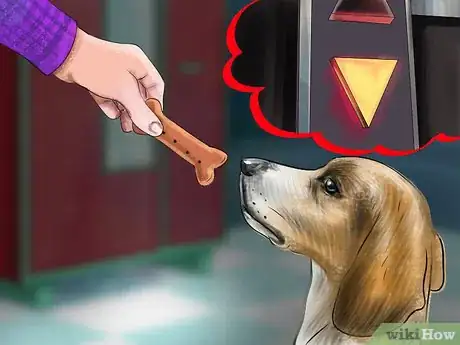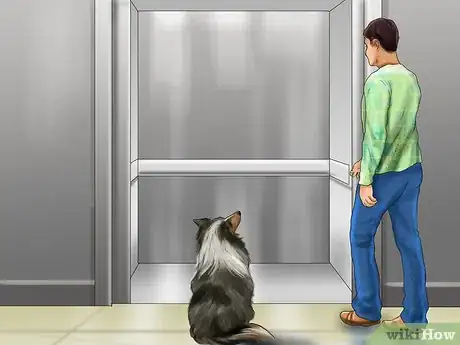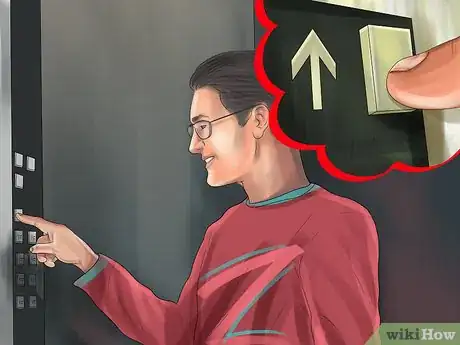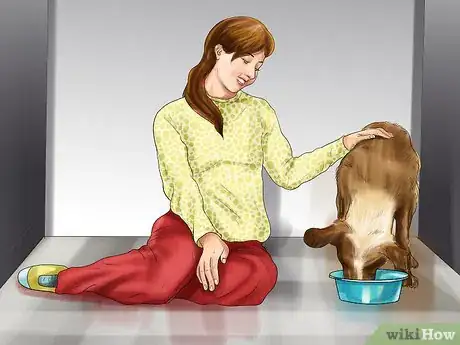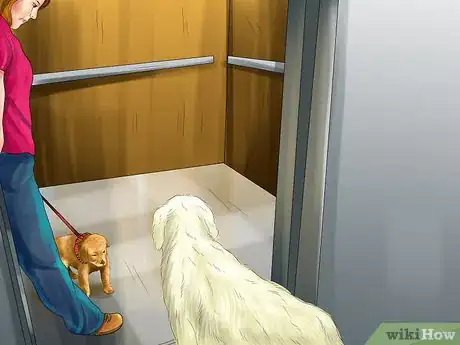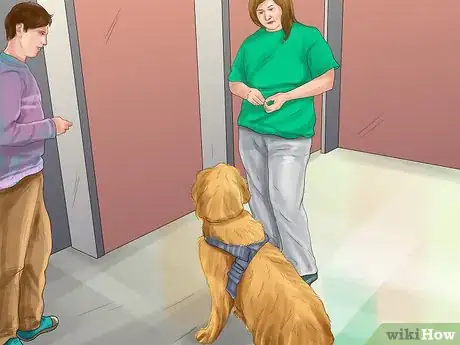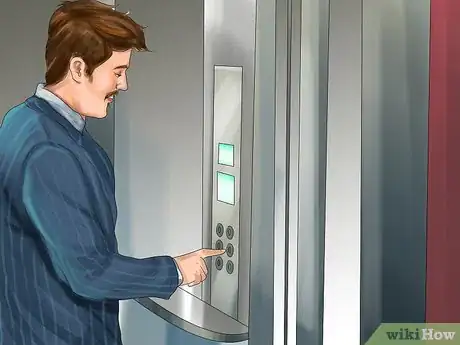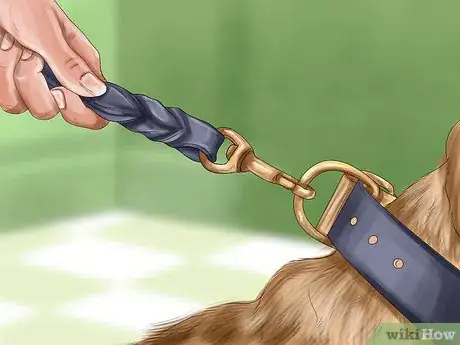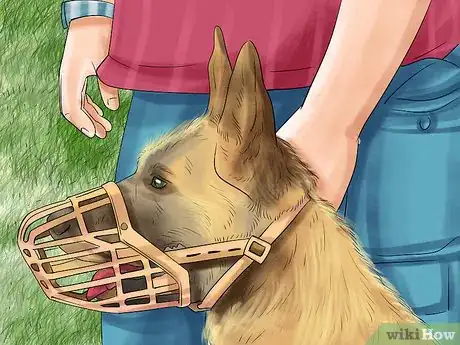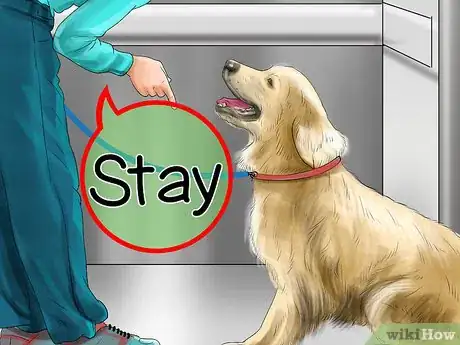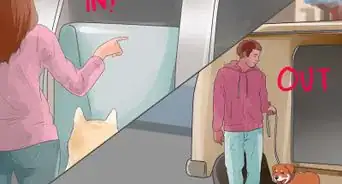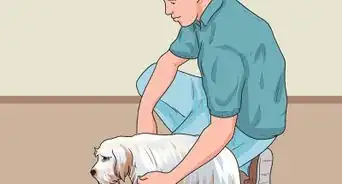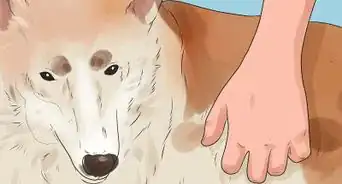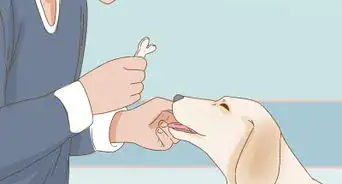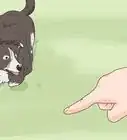This article was co-authored by Indigo Will. Indigo Will is a Canine Expert, Trainer, and Founder and Owner of K9-INDIGO® Holistic Dog Training LLC™, a dog training service in Los Angeles, California. Indigo specializes in understanding canine temperament and dispositions to allow canines to reach their full potential. He has studied various methods of training and philosophies to develop a unique, innovative, and result-driven method for canine behavior training.
There are 8 references cited in this article, which can be found at the bottom of the page.
This article has been viewed 20,651 times.
Using an elevator can be a strange experience for dogs, and some develop a fear of the confined space and odd motions. If your pup is afraid of elevators, you can use desensitization training to help it develop positive associations with elevator rides.[1] Start as early as possible, preferably by the age of twelve weeks. Gradually get it used to staying calm on a stationary elevator, then progress to going for short, one floor rides. Be sure to encourage it with small treats and plenty of verbal praise.
Steps
Desensitizing Your Pup
-
1Approach the elevator but don't enter it.[2] Introducing your pup to the elevator should be done gradually. Make the approach to the elevator fun for your dog so it makes a positive association with it. Bring treats, toys, and food along with you every time you approach the elevator until your dog feels at ease in the vicinity.[3]
- Give your dog plenty of praise every time you go near the elevator.[4]
-
2Give your dog a treat at the sound of the elevator “ding.” If your dog is afraid of elevators, it will associate the sound the elevator makes when it arrives with negativity. The first step to training is to recondition this negative association. As soon as you hear the “ding,” offer your dog a treat and verbal praise, like “Good dog!”[5]
- Make sure that you don't reward the dog if it's showing signs of a fear response, as this could reinforce the fearful behavior and make it intensify. Look for signs like shivering, lip licking, or showing the whites of its eyes. If your dog shows fear, distract it, then reward it with the treat when it calms down.
- When training your dog, break up treats into pea-sized bits. That way, you can offer lots of treats without negatively affecting its diet.
- When verbally encouraging your dog, use a calm, normal tone of voice. Project positivity and happiness, but avoid baby talk or cooing, or you might risk encouraging its anxiety.[6]
Advertisement -
3Enter the elevator then immediately exit. When the door opens, you should enter the elevator before your dog. Encourage it to enter the elevator by using an enthusiastic tone, tossing a treat into the elevator, or leading the dog with a favorite toy. Hold your arm in front of the door or press the “Door Open” button to keep it from closing.[7]
- Stay in the elevator for about one second, then exit. Don’t rush your movements, but try to keep them brisk and confident.
- Make sure that the dog has calmed down before you exit the elevator. If the dog is pulling to leave or is showing a fear response, then stepping out can teach it to use those behaviors to get out of situations it doesn't like. If your dog is exhibiting these behaviors, tell it to "sit" before stepping back out.
- Once you’ve exited the elevator, offer another small, pea-sized treat.
-
4Increase the time you spend on the stationary elevator gradually. If your dog seems to be tolerating the training well thus far, repeat the enter and exit sequence five or ten times. Gradually increase the amount of time you spend inside the elevator.[8] Work your way up to the point where you can let the elevator door close.[9]
- If your dog barks or starts to get anxious, let it take a break from training and start again in a couple hours or the next day. Wait until the dog calms down before you stop training. If you leave while it's barking or upset, the dog will learn to bark to get out of situations it doesn't like.
- If it stays calm when the elevator door closes, immediately reward it with a small treat and verbal praise.
-
5Send the elevator up or down one floor. After getting your dog used to being in elevator with a closed door, begin training it to stay calm in a moving elevator. Begin by going up or down one floor, and reward calm behavior with a small treat and verbal praise.[10]
- If your dog has been more comfortable in the past with one direction, start with that direction. Otherwise, it doesn’t matter which direction you send the elevator first during training.
- Repeat the training sequence at least once a day for several days, and gradually increase the number of floors you travel.
- You may want to teach your dog the "look" command to distract it from the movement.
-
6Consider giving your dog a meal in the elevator. For most dogs, mealtime is a strong positive motivator. If you have difficulty with desensitization training and your dog doesn’t seem interested in treats, try feeding it a meal inside the moving elevator.[11]
- Do your best to make sure your neighbors won’t be walking their dogs while food is in the elevator. If the elevator opens and you’re greeted by another dog, ask its owner politely if they mind taking the next elevator or giving you a minute to finish training.[12]
-
7Get help from another dog. If your pup has four-legged friends who are used to elevators, consider asking their owners for a play date. Other dogs can help show your pup that using an elevator isn’t scary.[13]
- If you get help from another dog, make sure that it and your pup have already been introduced and are comfortable with each other’s presence. Do not confine your dog in an elevator with a dog it doesn’t know.
Setting Your Pup up for Success
-
1Start elevator training your pup by twelve weeks. Puppies are most open to new experiences between eight and twelve weeks of age. You should start getting it accustomed to using elevators during this time.
- In addition to elevator training, you should expose your puppy to as many new experiences as possible, like other animals, children, other people’s homes, and car rides.
- If your dog is older, you can still use desensitization training to get rid of its fear of elevators.
-
2Train your dog when the elevator is in low demand. Schedule twenty minute training sessions during times when the fewest number of people will be riding the elevator. You don’t want to disrupt your neighbors’ daily activities, and you’ll want to keep training sessions as stress-free as possible.[14]
- Try to observe the elevator and note the times of day with the lowest traffic. Morning and evening rushes, when people are coming and going to work, will be obvious occasions to avoid.
-
3Stay calm and confident to reassure your pup. When training your pup and whenever you expose it to a new experience, be sure to monitor your own body language. Try to control your breathing and heartbeat to project calmness, confidence, and positivity.[15]
- Don’t panic if someone gets on or off the elevator, or if you encounter another dog. Say hello and be friendly. Your calm behavior will help cue your dog to keep its cool, regardless of age.
-
4Keep your dog’s leash short, but leave some slack. Like your body language, holding the leash with some slack will let your dog know that it shouldn’t be reactive. Holding a leash too tightly or pulling it tells your dog that you’re in a stressful situation and it should be on guard.[16]
- You don’t want to give your dog full reign or disregard the leash length. Shorten the length of the leash so you’ll have control if you need it, and be sure to keep it clear of the elevator’s moving parts.
Taking Precautions During Training
-
1Avoid walking your dog during periods of heavy canine traffic. If your dog is already stressed out by the elevator ride, coming into contact with strange dogs will only cause its anxiety to spike. While you’re training it to ride the elevator, do your best to avoid encounters with your neighbors and their dogs.[17]
- Try to keep track of when your neighbors walk their dogs. Most dog owners have fairly set walking schedules, so you should be able to identify peak times that you should avoid.
- You can also try talking to dog owners in your building or complex. Tell them, “I’m training my pup to stay calm on elevator rides, and it’d be best to steer clear of other dogs for now. Do you mind telling me what times of day you generally take your dog on walks?”
- If you take your pup out and hear a dog down the hall, wait at your door or out of visual sight for a minute or so.
-
2Consider using a muzzle. A muzzle will help you avoid a bad situation if your dog is larger or if you’re at all afraid that it might bite a passerby. Until it’s comfortable with elevators, riding them will be an upsetting experience with an increased risk of aggressive behavior.[18]
- Choose a plastic basket muzzle for your dog. Find one at your local pet store, and ask a sales associate to measure your dog’s snout and help you choose an appropriate size.
- Get the dog used to the muzzle by letting it sniff it, touching it to its nose, then putting it on and offering a treat. Try placing a bit of peanut butter inside the muzzle so your dog can lick it after you place it over its snout.
- Be sure to only use muzzles in combination with desensitization training. A muzzle is not a replacement for consistent, positive training.
-
3Train your dog to stay, wait, and look. Commands like ”stay”, ”wait”, and look will come in handy while elevator training your dog. When command training your dog, first say the command and, if necessary, physically guide your dog into the appropriate physical position.[19]
- As soon as it’s in the correct position, offer a pea-sized treat. Repeat the sequence ten to twenty times per training session to reinforce the behavior.
- Try not to let your dog ever enter or exit doors before you. This will help prevent your dog from leaping out of an elevator before you can see who or what is waiting to enter.
Expert Q&A
-
QuestionWhat do you do when your dog is scared of something?
 Indigo WillIndigo Will is a Canine Expert, Trainer, and Founder and Owner of K9-INDIGO® Holistic Dog Training LLC™, a dog training service in Los Angeles, California. Indigo specializes in understanding canine temperament and dispositions to allow canines to reach their full potential. He has studied various methods of training and philosophies to develop a unique, innovative, and result-driven method for canine behavior training.
Indigo WillIndigo Will is a Canine Expert, Trainer, and Founder and Owner of K9-INDIGO® Holistic Dog Training LLC™, a dog training service in Los Angeles, California. Indigo specializes in understanding canine temperament and dispositions to allow canines to reach their full potential. He has studied various methods of training and philosophies to develop a unique, innovative, and result-driven method for canine behavior training.
Professional Canine Expert Introduce them to whatever they're scared of gradually so you don't overwhelm them. Always have toys, treats, and food on hand to make it a positive experience for them. You should also offer them plenty of praise throughout the process.
Introduce them to whatever they're scared of gradually so you don't overwhelm them. Always have toys, treats, and food on hand to make it a positive experience for them. You should also offer them plenty of praise throughout the process.
References
- ↑ Indigo Will. Professional Canine Expert. Expert Interview. 8 September 2020.
- ↑ Indigo Will. Professional Canine Expert. Expert Interview. 8 September 2020.
- ↑ Indigo Will. Professional Canine Expert. Expert Interview. 8 September 2020.
- ↑ Indigo Will. Professional Canine Expert. Expert Interview. 8 September 2020.
- ↑ http://www.onetail.org/ask-a-trainer/july-ask-a-trainer-dogs-in-high-rises-a-modest-proposal/
- ↑ http://www.dogster.com/lifestyle/6-tips-for-navigating-hallways-and-elevators-with-your-dog
- ↑ http://www.clickertraining.com/lovin-an-elevator
- ↑ Indigo Will. Professional Canine Expert. Expert Interview. 8 September 2020.
- ↑ http://www.clickertraining.com/lovin-an-elevator
- ↑ http://www.clickertraining.com/lovin-an-elevator
- ↑ http://www.clickertraining.com/lovin-an-elevator
- ↑ http://www.onetail.org/ask-a-trainer/july-ask-a-trainer-dogs-in-high-rises-a-modest-proposal/
- ↑ http://www.dkc.ae/post/126/my-puppy-says-no-way-jose-to-elevators
- ↑ http://www.dkc.ae/post/126/my-puppy-says-no-way-jose-to-elevators
- ↑ http://www.dogster.com/lifestyle/6-tips-for-navigating-hallways-and-elevators-with-your-dog
- ↑ http://www.onetail.org/ask-a-trainer/july-ask-a-trainer-dogs-in-high-rises-a-modest-proposal/
- ↑ http://yourdogsfriend.org/life-with-dogs/reactive-dogs-in-multi-unit-buildings/
- ↑ http://www.akc.org/content/dog-training/articles/dog-muzzles-about-when-why-and-how-to-use-one/
- ↑ http://www.onetail.org/ask-a-trainer/december-ask-a-trainer-teach-your-dog-to-wait-at-doors/

